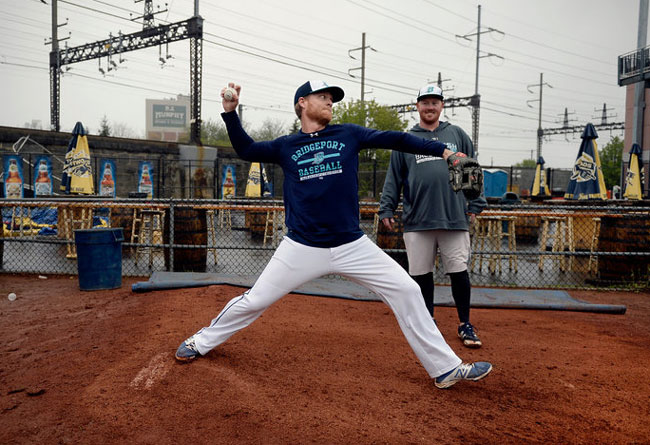Dan Johnson, 36, working on his knuckleball with the Bridgeport Bluefish pitching coach, Jesse Litsch
Credit Jessica Hill for The New York Times
By: Tyler Kepner
The jobs have kept coming for Dan Johnson. Eight organizations have employed him in the last five seasons. Every year, for at least a few days, he has been a major leaguer.
“You know what you’re going to get,” Johnson said. “I’m going to give you a quality at-bat. I’m going to work my way on base somehow, some way — and also, if you need some thump late, I’m going to give you that chance to tie it.”
That is what Johnson did in his most memorable moment, for the Tampa Bay Rays in the final game of the 2011 season. He came to bat in the bottom of the ninth inning, down by a run against the Yankees’ Cory Wade, with two outs and the bases empty. A playoff berth hung in the balance. Johnson hit a home run.
“The higher powers took care of it, because 99 times out of 100, if I hit that changeup away down the line, I’m going to hook it foul,” Johnson said. “Somehow, that time, that ball stayed fair. All the stars aligned. I have no idea how it happened.”
It was the second monumental homer of Johnson’s career (the other had come in a 2008 pennant race), and a 12th-inning blast by Evan Longoria, coupled with a Boston loss, sent the Rays to the playoffs. Johnson rejoined them this March, with a different job in mind.
He still hoped to be a power threat off the bench, but lots of players can offer that. Johnson could list a bonus skill on his job application: the ability to throw a knuckleball.
The Rays were intrigued. They have other knuckleballers in their system, and a former knuckleballer, Charlie Haeger, is their minor league pitching coordinator. In the enclosed, humid space of their dome, the Rays believe, a knuckleballer has a better chance to succeed.
In spring training, though, Johnson found two problems: his arm and the calendar. He cut loose a fastball and strained an elbow ligament. The Rays recommended two months of rest, but Johnson, 36, was eager to begin his new career sooner.
That is how he ended up with the Bridgeport Bluefish of the independent Atlantic League. Johnson is the team’s first baseman, but he also throws regularly in the bullpen and plans to soon take his knuckler into games. He is scheduled to throw a simulated game during the team’s next homestand.
“He’s like a Little Leaguer — raw, trying to learn how to pitch, which is great,” said the Bridgeport pitching coach, Jesse Litsch, a former Toronto Blue Jays starter. “He’s not starting from zero, because he’s seen enough. He knows how to throw. Being able to get that mind-set of going toward the catcher, staying on your backside and getting the hands out of the glove has been a process for him. But he’s been around the game enough, and he’s climbing quick.”
Johnson has fiddled with the knuckleball since childhood. His father, Ron, would throw him a pitch he called the Dancing Dazzler, entrancing Johnson and his friends, who could rarely hit it. The more Johnson toyed with his own version, the better he became at removing the knuckleball’s enemy: spin.
In 2013, when Johnson played for the Yankees’ Class AAA team, a coach, Gil Patterson, said he had heard of Johnson’s trick and asked him to test it in the bullpen. Encouraged, Johnson hoped to show off the pitch to his next team, the Toronto Blue Jays, the next spring. Then he pulled on a stray cord wrapped around a stack of weights just before reporting.
“Of course I smash my knuckleball finger and my nail falls off,” Johnson said, referring to his index finger. “I show up to spring training and they want me to do it, and I can’t because I don’t have a fingernail yet.”
Johnson, a right-hander, did collect pointers on the knuckleball from the Blue Jays’ R. A. Dickey, and now he is putting some to use. He is learning to keep his pitching arm from pulling past his lead leg when he releases the pitch. A knuckleballer should try to come straight down in his follow-through, Johnson said, to kill spin.
For all of Dickey’s success in 2012, when he won the National League Cy Young Award for the Mets, only one other major leaguer — Boston’s Steven Wright — is a regular knuckleballer. Many hopefuls struggle to perfect the knuckleball, in part because most coaches have no idea how to teach it.
Litsch never threw it but has studied video of Tim Wakefield and others, searching for cues to help Johnson’s mechanics. There is no question he can make the pitch dance; as he played catch recently, Johnson said, it veered so late into teammates’ shins that two of them gave up.
“I had to remember: Why was it working so well right then?” Johnson said. “So then I’m thinking again, and then it takes time to figure it out again. I need to get to where it’s repeated every time. That’s what I’m trying to do.”
Dickey visualizes himself throwing through a doorway and into a shoebox, and that makes sense to Litsch. At first, it seemed, Johnson was banging into the doorframe — or, Litsch said, switching the analogy, “running into the wall.”
Colliding with metaphorical walls is a job hazard for anyone learning the knuckleball. It is baseball’s most confounding pitch, but it also offers the most hope.
“What he’s trying to conquer, it could give him six more years in the big leagues,” Litsch said. “It’d be a great story. You never know unless you try.”
http://www.nytimes.com/2016/05/15/sports/baseball/a-veteran-retools-as-a-knuckleballer.html?mwrsm=Email&_r=0



